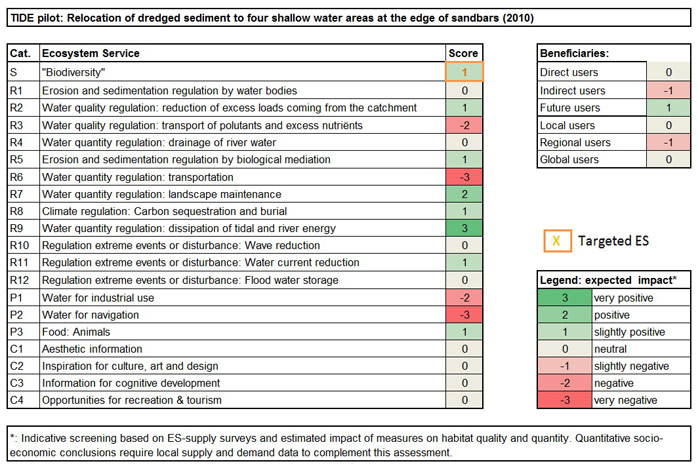

Disclaimer:
The authors are solely responsible for the content of this report. Material included herein does not represent the opinion of the European Community, and the European Community is not responsible for any use that might be made of it.
Back to overview measures
The measure TIDE pilot project 1 Sandbars (2010) in the polyhaline and mesohaline zone of the Scheldt estuary was about the relocation of dredged sediment to four shallow water areas at the edge of sandbars by transforming mainly subtidal deep habitat into subtidal shallow habitat without changing the habitat quality.
Before the measure, the relocation area consisted mainly of subtidal deep habitat and a small part of subtidal moderately deep habitat and subtidal shallow habitat.
After the implementation of the measures (2015, Figure 4 - Figure 6), the creation of more low dynamic subtidal shallow habitat is expected.
Step 2: Expected impact on ecosystem services, compared with targeted ecosystem services, and expected impact on beneficiaries
More information about the methodology and the correct interpretation of the results could be found in the overall measures report (Saathoff et al. 2013).
(1) Overall expected impact on ES:
From the ES assessment it is concluded that this measure generates both positive and negative expected impact on ES. A positive to very positive expected impact is indicated for Water quantity regulation (dissipation of tidal and river energy); and Water quantity regulation (landscape maintenance). A slightly positive expected impact is indicated for “biodiversity”; food (animals); and some regulating services. A negative to very negative expected impact is indicated for Water quality regulation (transport of pollutants and excess nutrients); Water quantity regulation (transportation); Water for industrial use; and Water for navigation.
The transformation from subtidal deep to subtidal shallow water is in general indeed negative for transportation. But in the local context of the relocation of dredged material at the edges of the Walsoorden sandbar it was proven that it contributes to the maintenance of the multiple channel system, which is positive for transportation.
(2) Expected impact on targeted ES
The expected impact on the development target creation of low dynamic areas (ES habitat services “biodiversity”) is slightly positive.
(3) Expected impact on beneficiaries
The expected impact for the different beneficiary groups is slightly positive for future users, but slightly negative for indirect use and regional use.
Back to top
TIDE pilot 1: large scale execution “plaatrandstortingen” (2010), relocation of dredged sediment to shallow water areas near sandbars
Table of content
- 1. Description of measure
- 1a. Measure description
- 1b. Monitoring
- 1c. Monitoring results
- 2. Execution of main effectiveness criteria
- 2a. Effectiveness according to development targets of measure
- 2b. Impact on ecosystem services
- 2c. Degree of synergistic effects and conflicts according to uses
- 3. Additional evaluation criteria in view of EU environmental law
- 3a. Degree of synergistic effects and conflicts according to WFD aims
- 3b. Degree of synergistic effects and conflicts according to Natura 2000 aims
- 4. Crux of the matter
- 5. References
Additional information
for this measure:
No further information available.
for this measure:
No further information available.
Impact on ecosystem services
Step 1: Involved habitatsThe measure TIDE pilot project 1 Sandbars (2010) in the polyhaline and mesohaline zone of the Scheldt estuary was about the relocation of dredged sediment to four shallow water areas at the edge of sandbars by transforming mainly subtidal deep habitat into subtidal shallow habitat without changing the habitat quality.
Before the measure, the relocation area consisted mainly of subtidal deep habitat and a small part of subtidal moderately deep habitat and subtidal shallow habitat.
After the implementation of the measures (2015, Figure 4 - Figure 6), the creation of more low dynamic subtidal shallow habitat is expected.
Step 2: Expected impact on ecosystem services, compared with targeted ecosystem services, and expected impact on beneficiaries
More information about the methodology and the correct interpretation of the results could be found in the overall measures report (Saathoff et al. 2013).
(1) Overall expected impact on ES:
From the ES assessment it is concluded that this measure generates both positive and negative expected impact on ES. A positive to very positive expected impact is indicated for Water quantity regulation (dissipation of tidal and river energy); and Water quantity regulation (landscape maintenance). A slightly positive expected impact is indicated for “biodiversity”; food (animals); and some regulating services. A negative to very negative expected impact is indicated for Water quality regulation (transport of pollutants and excess nutrients); Water quantity regulation (transportation); Water for industrial use; and Water for navigation.
The transformation from subtidal deep to subtidal shallow water is in general indeed negative for transportation. But in the local context of the relocation of dredged material at the edges of the Walsoorden sandbar it was proven that it contributes to the maintenance of the multiple channel system, which is positive for transportation.
(2) Expected impact on targeted ES
The expected impact on the development target creation of low dynamic areas (ES habitat services “biodiversity”) is slightly positive.
(3) Expected impact on beneficiaries
The expected impact for the different beneficiary groups is slightly positive for future users, but slightly negative for indirect use and regional use.

